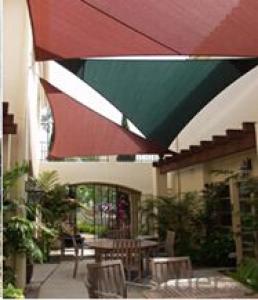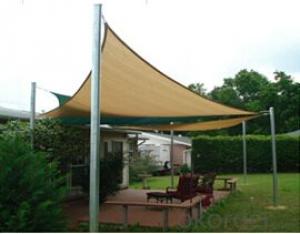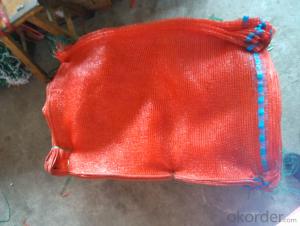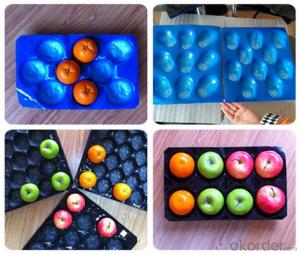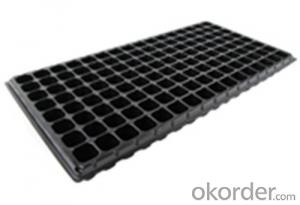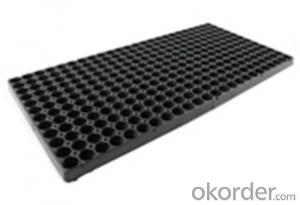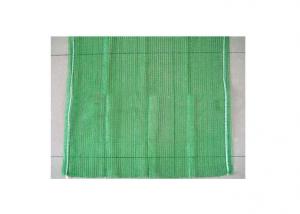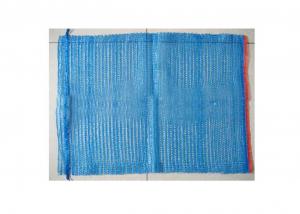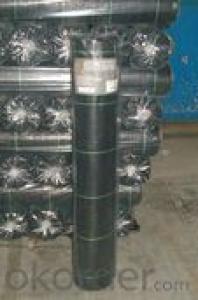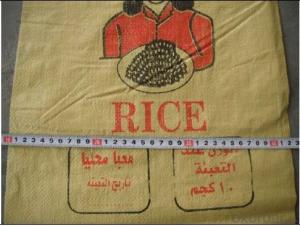Shade Cloth 185gsm in rolls
- Loading Port:
- Ningbo
- Payment Terms:
- TT OR LC
- Min Order Qty:
- -
- Supply Capability:
- 50000pcs pc/month
OKorder Service Pledge
OKorder Financial Service
You Might Also Like
Shade Sail water-proof cloth sail 160GSM
Net weight: 160g/m2--320g/m2
Size: 3x3m, 3.6x3.6m 3x3m, 3x3x3m,5x5m,5x5x5m and so on UV block: 85-95%
Material: 100% virgin HDPE
Using life: 5 ~10 years Gurantee
Export market: Europe ,America,Japan, the Middle East ,Africa
Shape: Square, Triangle , Rectangle
Packaging & DeliveryPackaging Detail: Each piece of sail will be put into a pvc hadle bag with a color label inside, seveal pcs packaging into a paper carton with shipping mark.
Product Description of shade sail shade cloth:
Shade Sails protect and shade you from the severe effects of the sun's heay & UV rays. Some areas of the world call them Sun Sails.
They make a beautiful additions to your patio, backyard, or other outdoor areas.
Flying Sails is the perfect alternative to a traditional pergola, umbrella or covered porch. Floating and curvaceous, the make an attractive addition to any property, and with the right design,
they can enhance the appeal of the entertaining outdoor areas..
The perimeter of each sail is designed with a gentle cantenary curve inwards towards the center of the sail to control the fabric tension. Shade sails have reinforced webbing around the perimeter and marine stainless steel D or "Delta" rings at each corner. When properly tensioned, shade sail fabric will not wrinkle, sag, or flap in the wind.
- Q: Can nursery trays be used for succulents?
- Yes, nursery trays can be used for succulents. However, it is important to ensure that the trays have good drainage holes to prevent water from pooling and causing root rot. Additionally, using nursery trays with individual cells can help prevent overcrowding and promote proper airflow around the succulents.
- Q: How do agricultural plastic products help in improving plant health?
- Agricultural plastic products help in improving plant health by providing a protective barrier against pests, weeds, and harsh environmental conditions. They can be used as mulches to retain moisture in the soil, regulate temperature, and prevent weed growth, leading to enhanced plant growth and reduced water requirements. Additionally, plastic tunnels or covers can create a controlled microclimate, protecting plants from extreme temperatures, wind, and rain. These products also enable efficient irrigation systems that deliver water directly to the plant roots, minimizing water wastage and promoting healthier plant growth.
- Q: What are the different types of plastic crates used in agriculture?
- There are several different types of plastic crates commonly used in agriculture, including harvesting crates, storage crates, and transport crates. Harvesting crates are designed for collecting and transporting fruits, vegetables, and other crops from the field. Storage crates are used to store and organize produce in coolers, warehouses, or distribution centers. Transport crates are specifically designed for efficient and safe transportation of agricultural products from farms to markets or processing facilities. These crates are typically made from durable and food-safe plastic materials to ensure the quality and freshness of the produce.
- Q: Can agricultural plastic products be used for shade netting?
- Yes, agricultural plastic products can be used for shade netting.
- Q: What are the recent advancements or innovations in the field of agricultural plastic products?
- <p>Recent developments in agricultural plastic products include the use of biodegradable plastics, advancements in mulching films, and smart greenhouse technologies. Biodegradable plastics are being developed to reduce environmental impact, with materials like PLA (polylactic acid) and PHA (polyhydroxyalkanoates) gaining attention. Mulching films have improved to enhance crop growth, water retention, and soil health. Additionally, smart greenhouses with integrated plastic components are becoming more sophisticated, offering automated climate control and energy efficiency. These advancements aim to increase agricultural productivity while minimizing environmental harm.</p>
- Q: How do agricultural plastic products contribute to soil moisture retention?
- Agricultural plastic products, such as mulch films and drip irrigation systems, contribute to soil moisture retention by creating a physical barrier that reduces evaporation. These plastic materials help to conserve water by preventing direct contact between the soil surface and the atmosphere, minimizing water loss due to evaporation. Additionally, plastic mulch films also assist in reducing weed growth, which further helps to conserve soil moisture by minimizing competition for water resources.
- Q: What are the different types of additives used in agricultural plastic products?
- The different types of additives used in agricultural plastic products include UV stabilizers, antioxidants, colorants, plasticizers, flame retardants, and antimicrobial agents.
- Q: Can agricultural plastic products be used for biodegradable mulching?
- Yes, agricultural plastic products can be used for biodegradable mulching. Biodegradable mulch films are made from plastic materials that break down over time into natural compounds, reducing environmental impact compared to traditional plastic mulches. These biodegradable mulch films provide weed suppression, moisture conservation, and soil temperature control, while also degrading into harmless substances.
- Q: How do nursery trays help in reducing the use of plastic pots for plant propagation?
- Nursery trays help in reducing the use of plastic pots for plant propagation by providing a more efficient and sustainable method of growing plants. Instead of using individual plastic pots, nursery trays allow multiple plants to be grown in a single tray, minimizing the amount of plastic needed. These trays are reusable and can be used for multiple growing cycles, reducing the overall plastic waste generated. Additionally, nursery trays promote better plant root development and airflow, resulting in healthier and stronger plants.
- Q: What are the rules and guidelines that govern the use and disposal of plastic products in agriculture to protect the environment?
- <p>Environmental regulations related to agricultural plastic products vary by region, but generally aim to reduce pollution and promote sustainable practices. These may include guidelines for the use of biodegradable plastics, restrictions on single-use plastics, regulations on the disposal of plastic waste, and requirements for recycling. For example, the European Union has implemented regulations like the Single-Use Plastics Directive, which bans certain plastic items and encourages the use of alternatives. In the United States, the EPA oversees plastic waste management, and some states have specific regulations. It's crucial for farmers to be aware of local regulations to ensure compliance and minimize environmental impact.</p>
Send your message to us
Shade Cloth 185gsm in rolls
- Loading Port:
- Ningbo
- Payment Terms:
- TT OR LC
- Min Order Qty:
- -
- Supply Capability:
- 50000pcs pc/month
OKorder Service Pledge
OKorder Financial Service
Similar products
Hot products
Hot Searches
Related keywords
